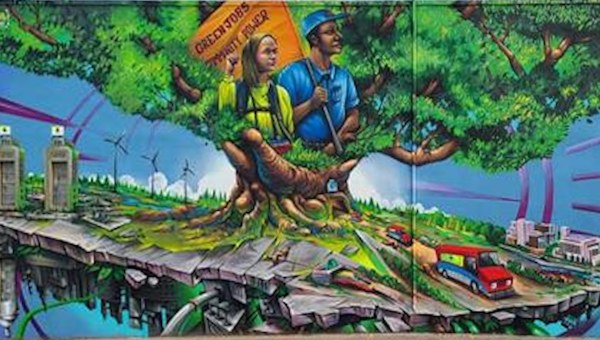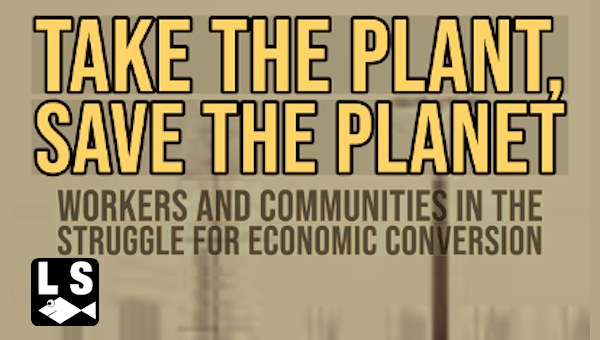At the UN Climate Change Conference COP 19, the even-more-depressing-than-usual climate summit that took place in Warsaw in 2013, one small ray of light made it through the dark corporate clouds that were otherwise suffocating even the slightest effort to address the ongoing environmental disaster. On the last day of the conference, an unusual alliance was formed as environmental organizations and trade unions together walked out of the venue under the banner of “Enough Is Enough.” Sick of the meaningless talks, they stated:
 “We are now focusing on mobilizing people to push our governments to take leadership for serious climate action. We will work to transform our food and energy systems at a national and global level and rebuild a broken economic system to create a sustainable and low-carbon economy with decent jobs and livelihoods for all. And we will put pressure on everyone to do more to realize this vision.”
“We are now focusing on mobilizing people to push our governments to take leadership for serious climate action. We will work to transform our food and energy systems at a national and global level and rebuild a broken economic system to create a sustainable and low-carbon economy with decent jobs and livelihoods for all. And we will put pressure on everyone to do more to realize this vision.”
If not entirely unique, this action nevertheless promised a new hope for a climate movement that never recovered after its (greatly exaggerated) expectations cruelly disappointed at the summit in Copenhagen four years earlier. The relationship between trade unions and environmentalists has often been strained, if there has been one at all. More often than not, those claiming to defend the earth and workers’ rights are operating at a crossroads, sometimes colliding in head-to-head confrontation – especially when jobs are pitted against environmental interests.
Two Crisis
I found myself in that squeeze when the financial crisis hit the auto industry in 2008. The previous year, Al Gore and the Intergovernmental Panel on Climate Change (IPCC) were awarded the Nobel Peace Prize, and climate change topped worldwide headlines. But with the bankruptcy of Lehman Brothers and the auto industry in free fall, the climate crisis quickly disappeared from general discussion, even more so among auto-industry workers. Profits (disguised as “jobs”) were the main issue, not the complicated and distant phenomenon of global warming.
This was very much the case in Sweden, a small country with two crisis-hit U.S.-owned car producers (Volvo and Saab), two truck corporations (Volvo Trucks and Scania), and a widespread network of subcontractors, making the industry a pillar of the national economy. In the debate over what to do about the crisis, two positions quickly crystallized in Sweden, much as they did in other car-producing countries:
- “Let it die!” This position was represented by true believers of the invisible hand and creative destruction – a rapidly shrinking flock at the time.
- “Support the industry!” In most countries, this became the rallying call of unions, social democrats, governments – and, naturally, the industry itself. They advocated subsidies of various kinds, from “cash for clunkers” to the involuntary quasi-nationalization of GM and Chrysler – and to varying degrees, sacrifices from auto-industry workers.
Needless to say, the “Let it die!” position – notoriously articulated in the United States by Mitt Romney – was no alternative for workers. In the case of Sweden, it would have had huge social implications in an economy in which unemployment was already skyrocketing, particularly in an auto-dependent city like my hometown, Gothenburg. It also would have caused enormous social waste. The auto industry is not merely buildings, robots, and assembly lines: it’s first and foremost an organization of people, who together make up an industrial machine built and perfected for more than one hundred years. “Let it die!” targets not just the metal scaffolding but the human component of the industry. And from a working-class point of view, it would have dissolved autoworkers as a collective and the potential social subject for change.
If cars were a social necessity, I wouldn’t per se be against the second position of “support the industry!” Governments support all sorts of things, like education, healthcare, culture, and more (albeit, now less than ever). The problem is that cars are unnecessary. The present transportation system, based on mass auto transit, is completely unsustainable. It is a threat to humanity.
Main Contributors to CO2 Emissions
Transport, and primarily road transport, is one of the main contributors to CO2 emissions that threaten to push the globe over extremely dangerous thresholds. Dependent on oil for 95 per cent of its fuel, road transport accounts for 27 per cent of global CO2 emissions and 13 per cent of all greenhouse gas emissions, and those shares are rapidly increasing.
Transportation has been growing faster than the rest of the global economy, pushed forward by globalization, just-in-time production, and car-centered city planning – all based on the abundance of cheap fossil fuels. This is not news to the auto industry. After a brief flirtation with denialism, auto makers quickly adapted to equipping products with stickers proclaiming them “green,” “eco,” or some other environmentalist catchword.
The main lines of defense of the status quo have been fuel-efficient cars, bio-fuels, and electric cars. And it is true: the average of CO2 emissions per mile from new cars is going down. But this is thoroughly overcompensated by the increasing number of miles covered by an ever-growing global fleet of cars.
As for bio-fuels, there is simply no way to substitute bio-fuels for fossil fuels at the present scale of consumption. No serious assessment gives them more than a minor role in propelling the world’s cars. Moreover, even if the blame for the 900 million undernourished, or starving, in the world today is to be found more in distribution than absolute scarcity of food, production of bio-fuels for cars – more appropriately named “agro-fuels” – is a deeply questionable way of using the world’s arable land.
Then there’s the electric car. The car of the future – clean, silent, magically propelled by electric energy – a technical fix, now as always, just around the corner, telling us that if we act like responsible consumers, there’s really no need to worry. It will be possible to maintain the auto society (and the auto industry), making effort to imagine alternatives unnecessary.
But electric cars don’t represent a way out of the fossil society – not today or in the foreseeable future. Electricity doesn’t appear out of thin air. Two-thirds of electrical power in the world comes from burning coal, oil, or natural gas, in most cases making the electric car slightly more efficient than the fossil car, a showpiece used to greenwash the auto industry and lull us into the dream that the environmental problems of road traffic will soon be taken care of.
Furthermore, since the production of an electric car generates considerably more greenhouse gas than the manufacturing of a conventional one, it has to run on renewables for tens or hundreds of thousands of miles before it is any better for the environment than a regular car. The talk of the green fuel-efficient car running on renewables is an illusion. Instead, the transportation system has to change in three ways: from private to public, from roads to rail, and, above all, transport has to be drastically reduced.
These, of course, have huge implications for the auto industry. It’s just not possible to keep producing 70 million units a year. Basically, a transition to an economy that does not systematically destabilize the earth’s climate would entail the end of the industry as we know it.
“None of the Above”
The Case for Conversion
So facing a choice – between seeing the jobs of my co-workers and myself go down the drain or demanding subsidies for pushing the earth further down the highway to hell – I opted for “none of the above.” Instead, I’ve been arguing for something I call “conversion”: that is, transforming the auto-industrial complex to save jobs and the planet.
At first, the idea was more of a quick one-liner when journalists asked me to comment on the crisis, but, as I dug deeper, I found the case for conversion was very strong – that it’s actually a viable strategy against both unemployment and climate change, both practically and politically.
First, breaking free from the fossil economy requires more than a mental or emotional commitment to the idea (though even that commitment is deplorably absent). Its material components, such as the present means of transportation and energy production, would have to be replaced. This has to be done quickly and on a massive scale. And if there is one thing the auto industry is good at, it’s mass production of technically complex equipment. The assembly line was perfected in this pursuit. Mass production turned the car from a luxury item into the means of transportation in industrialized countries and the foremost symbol of mass consumption.
Second, conversion of the auto industry is technically feasible. If mass production is the auto industry’s first basic feature, change is the second. Ever since GM overtook Ford using a never-ending flow of new models as a method for marketing cars, the constant change of products has been an industry hallmark. Through the marketing genius of GM’s Alfred Sloan, the auto industry became the birthplace for “conspicuous consumption” on a broad scale. New models were launched every year to make last year’s model outdated.
Far from running out of force, this marketing trick has become the main competitive tool in the auto industry. In the eighties, a new European car had a concept-to-production life-cycle of slightly more than ten years; twenty years later, it’s six years; today, the average car is in production for just four, with the time to develop and introduce new models shrinking correspondingly. No matter how wasteful this practice is, it has created organizations that are extremely skilled in rapid change and conversion.
This has also made the industry exceptionally versatile. It was the only American industry that underwent complete conversion to supply the World War II effort: only months after Pearl Harbor, Detroit’s assembly lines stopped producing cars to instead churn out tanks, planes, and guns.
This kind of knowledge – both of mass production and conversion – permeates the industry. Even at the lowest level, on the shop floor, where I work, there is deep tacit knowledge of the art of mass production and the methods used. And of no less importance, we are accustomed to constant change.
In short: the auto industry is not a coal mine. It’s a flexible machine that society can use to make almost anything on a large scale. Send us the blueprints for socially useful stuff, and we’ll make it!
Politics and Social Power
Such practical factors are reason enough to use the auto industry – this amazing machine – for the benefit of society. But they are not the most important. Rather, it is this: the climate question is not about technology, not about science. At the bottom, it’s about politics and social power, the relationship of forces: class struggle.
In the 23 years since 192 governments signed the United Nations Framework Convention on Climate Change, committing themselves to stabilizing greenhouse-gas levels “that would prevent dangerous anthropogenic (human-induced) interference with the climate system,” there has been a tremendous increase in emissions, parallel to the growth in scientific knowledge about how this threatens our existence.
The reason is, of course, that reason isn’t enough. The interests tied to the fossil-fuel economy are so gigantic that the only possible solution – “keep the oil in the soil” – would mean not only opposing the fundamental logic of the capitalist system but also a head-on confrontation with the most powerful corporations of the world – telling them that they can no longer access the assets they build their value on, thus rendering them worthless. However reasonable this may be from humanity’s point of view, there’s no way they’re going to accept this. When it comes to the climate issue, as in so many other cases, reason stands against the power of mighty interests. And in a struggle between reason and power, power wins one hundred times out of one hundred.
To stand a chance, reason has to be armed with social power. The autoworkers’ fight for jobs could be part of arming reason, if we, instead of accepting the usual choice between jobs and environment, decide to tie our struggle for jobs to plans to convert the industry for the benefit of society. This struggle could create a focal point for a broad social movement for conversion of the whole society.
Of course, these arguments for conversion are valid not only in times of economic crisis and not only for the auto industry. All industries have workforces with deep technical knowledge. In many cases, it’s both possible and necessary to use this knowledge to radically change the output of the industry. Putting this strategy into practice, though, is probably only possible in a situation in which jobs are profoundly threatened, and broad layers of workers are prepared to look for radical solutions. Given the present volatile condition of the world capitalist system, this situation is never far away, especially in the auto industry, where overproduction is always lurking around the corner.
There are several arguments for this strategy. If we are to win anything at all, we have to keep the collective together as much as we can. More traditional demands of replacement jobs and job training tend to move the initiative away from the shop floor and make it an issue between individual workers and the government or some employer. General talk of “green jobs” can work in the same way, especially if you’re not very precise about what a “green job” is. I am not fond of the “green job” concept. Just as less environmentally disruptive cars shouldn’t be called “environmentally friendly,” less environmentally disruptive jobs shouldn’t be called ”green.”
Moreover, jobs that don’t in themselves physically produce many CO2 emissions can have a very disruptive social and ecological impact – like much of the financial sector. Rather than “green jobs,” we should talk about “climate jobs” and “socially necessary jobs” – i.e., jobs that decrease greenhouse-gas emissions as well as benefit society in general. Programs and plans for social investments in climate jobs are an important part of a strategy for breaking away from the fossil society. The problem is that this can be easily transformed into lofty promises by politicians beyond the control of working people.
Conversion: Something We Can Fight For
Conversion of an existing industry, on the other hand, is something we can fight for, as a solution for all, through our unions and in alliance with other social movements. This is essential if we want to win, instead of leaving the initiative to state bureaucrats and the like.
The only significant example of this that I’m aware of took place in Great Britain in the seventies at the Lucas Aerospace Company. Faced with cutbacks in military spending, and encouraged by a new Labour government aiming to nationalize parts of the aviation industry, unions at Lucas broke with their earlier habit of demanding more government funding for armaments to save jobs. Instead, they involved the membership at the various plants in developing a plan for a large number of socially useful products, like affordable heat pumps, hybrid vehicles, and solar cells. Even if their struggle eventually was defeated by fierce corporate resistance, labour bureaucracy, lack of governmental support, and finally the election of Margret Thatcher for prime minister, the plan was used as a means to mobilize support and made an impression throughout the world.
Implementation of “alternative production,” as it was called, faced other, less head-on challenges. In the late 1970s, several industrial sectors in Sweden were mired in crisis: ship building, steel, the last remnants of the textile industry. For a period, “alternative production” became a buzzword among fairly broad segments of workers, with inspiration from Lucas, and even some direct contacts with workers there.
But almost all attempts to save jobs under this banner failed, because “alternative production” came to mean “other profitable products.” The great strength of the Lucas Plan – focusing on social usefulness, rather than profit – was edged out of the game. Advancing that original vision means questioning the private control and ownership of most of the world’s assets, and recognizing the broad swaths of workers who want to and can use their skills to produce socially useful and necessary products.
There is another appealing aspect of the Lucas experience: the horizons that open up when we step off the treadmill. In the late eighteenth century, Thomas Paine captured those horizons in a few words:
“Revolutions create genius and talent; but these events do no more than bring them forward. There is existing in man, a mass of sense lying in a dormant state, and which, unless something excites it to action, will descend with him, in that condition, to the grave.”
Having spent decades doing mindless jobs on the assembly line, I think there is great power in this perspective. It’s hard to question the content of the whole production process without at the same time questioning the degrading and impoverishing work that has been at the heart of industrial capitalism from the outset, and where the auto industry has been at the forefront of exploitation, from the first division of labour at Ford’s assembly line to the hyper-Taylorism developed at Toyota and spread worldwide as “lean production.”
In my opinion, the most important reason to raise the issue of conversion as a response to the double crisis of the economy and the environment is its collective nature. This kind of process is not possible on a local level alone. The auto-industrial complex is too big, and the things we could replace present production with – like wind turbines or railway equipment – need decisions and investments on a social level to guarantee the output. All this points to the need for nationalizing the industry and putting it under social control.
Its present captains, thoroughly drilled in the art of profit maximization, are not the kind needed on the bridge when we undertake the complex maneuver of turning this big ship into the new course of socially and environmentally necessary production. The fight for conversion has to have strong shop floor roots, both for political and practical reasons. After all, it’s we who are running the machine today. Who would be better positioned to lead and oversee the conversion? It’s important to stress that autoworkers are not, of course, the climate conscience of the world. We’re no better or more inclined to make sacrifices for the common good than the next person. But that’s not the question.
In the spring of 2008, as the financial crisis was gaining steam, I took part in a debate on national Swedish radio with, among others, the Swedish minister for enterprise and energy, Maud Olofsson. When I spoke in favor of converting the auto industry, the journalist asked me if I wasn’t cutting off the branch I was sitting on. I answered that it’s the other way around: if we cling to the present unsustainable production and act as a support group for the owners of the industry (a time-honored tradition of our union leaders) – that is cutting off the branch we’re sitting on.
With a strategy for conversion, on the other hand, we in the auto industry can be a crucial part of solving the most important task of our time – not by sacrificing ourselves but by fighting for our own immediate interests.
The climate issue in itself is so immense that we tend to be unwilling to think of it at all, since we wouldn’t know what to do about the whole thing, resulting in a kind of “socially organized denial.” Even if we accept that things must change, the scope of change needed easily induces a sense of powerlessness. The people most of us think should fix this kind of problem – politicians, industrial leaders, other representatives of the present order – are obviously not doing it. So how could we then do anything? Conversion of our jobs could be a way to put the issue inside everyday reality, within reach for workers, as opposed to looking to distant “world leaders” and “experts” to fix things for us.
Industries ravaged by corporate elites should be transformed into a common asset that produces value for society, not profit for private owners. This also makes the demand for conversion and climate jobs a transitional demand, starting in the most immediate material needs, connecting them to the long-term needs of humanity, questioning the right of a small minority to decide our fates.
The Future: Commitments and Mobilizations
And now? What, then, was the outcome of the promising alliance in Warsaw, the commitment by unions to mobilize people, push governments, and transform the economy? It’s probably fair to say that the overwhelming majority of unions have so far failed not only to mobilize their members, but to address the climate issue at all. The leadership has not tried to integrate climate change into everyday union work.
Granted, there are a few examples: the union participation in the big climate demonstration in New York; the climate program adopted by the International Transportation Federation; the unions supporting climate job campaigns in Great Britain, South Africa, and Norway.
But these are exceptions, each with their own history and with no link to the lofty declarations from Warsaw. And in most cases, they too lack the necessary connections to the rank-and-file struggle that is and must always be the backbone of a union’s strength.
In the ongoing preparations for the alternative activities around COP 21 in Paris, there are unions involved alongside environmental activists. Climate jobs are on the alternative agenda. But so far, it’s mostly individuals who are driving the issue in unions and it’s seldom built from the rank-and-file level. It’s also easily drowned out in competition with “real” union business.
The powers that be have failed to solve the climate question. They are neither willing nor able to challenge the dominance of fossil capital and the process of accumulation of capital that drive this economic system as well as global warming. The change has to come in confrontation with their power, from below. Demonstrations and gatherings by activists in the streets are all fine, but not enough. The fight has to involve millions of people in our everyday life. The case for conversion is about turning every possible workplace into a battleground against climate change. •
This article first appeared on the Jacobin website.





